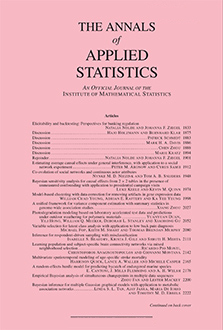Abstract
Individuals of protected species, such as amphibians and reptiles, often need to be removed from sites before development commences. Usually, the population is considered to be closed. All individuals are assumed to (i) be present and available for detection at the start of the study period and (ii) remain at the site until the end of the study, unless they are detected. However, the assumption of population closure is not always valid. We present new removal models which allow for population renewal through birth and/or immigration, and population depletion through sampling as well as through death/emigration. When appropriate, productivity may be estimated and a Bayesian approach allows the estimation of the probability of total population depletion. We demonstrate the performance of the models using data on common lizards, Zootoca vivipara, and great crested newts, Triturus cristatus.
Citation
Eleni Matechou. Rachel S. McCrea. Byron J. T. Morgan. Darryn J. Nash. Richard A. Griffiths. "Open models for removal data." Ann. Appl. Stat. 10 (3) 1572 - 1589, September 2016. https://doi.org/10.1214/16-AOAS949
Information





